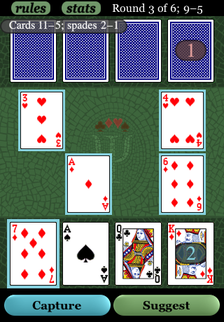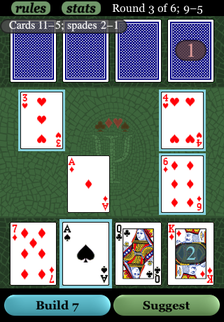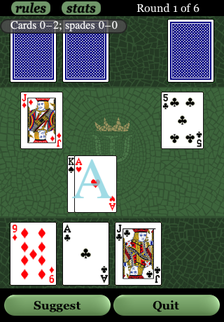Cassino Rules
Cassino is a classic two-person card game using the standard 52-card deck. In the webapp at cassino.psellos.com, you play against an algorithm running in the browser. According to Wikipedia, Cassino is around 230 years old. Over the years there have been several variants of the basic game. The webapp plays three of them:
Traditional Cassino — the standard game that has been played since the late 1700s.
Royal Cassino — a variant from 100 years later in which the court cards (king, queen, jack) are given numeric values like the rest.
Casual Cassino — an impromptu version of Royal Cassino with simplified scoring. It can serve as a simple introduction to Cassino, or a way of playing a quick game.
This note describes the rules of the traditional game, and the small differences of the other variants from the traditional one.
Traditional Cassino
At the beginning of a game, 4 cards are dealt to each player and 4 cards are placed face up between the players. The face up cards at the bottom of the screen are your hand. The app also has a hand, face down at the top of the screen. You take turns trying to capture cards in the middle. You should think of the cards in the middle as being on a table between the two of you.
In a real-life game, to capture cards means to physically take them from the middle of the table (along with one card from your hand) and keep them in a nearby pile. In the app, just the counts of captured cards are shown near the top of the screen.
At each turn, you play one of your cards. Then the app plays one of its cards, and so on. When you and the app run out of cards, you each get four more from the deck. A game consists of six rounds like this.
The object of a game is to capture specific cards that are worth points. The following cards and combinations are worth points when captured.
| 10 of diamonds | 2 points |
| 2 of spades | 1 point |
| Each ace | 1 point |
| Most cards | 3 points |
| Most spades | 1 point |
| Each sweep | 1 point |
The 3 points for most cards are awarded at the end of the game to the player who has captured the majority of the 52 cards, namely 27 cards or more. If both players capture 26 cards, the 3 points are not awarded. The point for most spades is awarded to the player who captures 7 or more spades. A sweep occurs when a player captures all the cards on the table in one play.
You play a series of games against the app until one of you has 21 points or more. We’ll call this series of games a match. Once a player reaches 21 points, the winner of the match is the one with the most points at the end of that game. In case of a tie, you play another game to break the tie.
Leaving aside the sweeps, if you add up the points you’ll see that 11 points are awarded in each game. So a match will generally be three or four games.
The app will allow you to play first in the first game of every match, if you wish. You can touch the Pass button to have the app play first in the first game. After that you and the app take turns playing first in successive games.
There are three types of plays that you can make when it is your turn: capture, build, and trail.
Capture
The basic point-scoring play is to capture a card on the table with the same value of card from your hand. To make things more interesting, the non-court cards (all but jack, queen, and king) are given a numeric value. For the two through nine, the value is the one printed on the card (i.e., also 2 through 9). The ace is worth 1.
Keeping these numeric values in mind, you can capture several cards if their values add up to the value of the card from your hand. In fact, you can capture any number of groups of cards that add up to this value.

Figure 1
Capture Possibilities
As you and the app capture cards from the table, accumulated points from the above list (including sweeps) are displayed for each player. The counts of cards and spades are also displayed but points are not awarded until the end of each game.
In Figure 1, you could capture the ace on the table with the ace from your hand. This would be worth 2 points (for the two aces) and would add 2 cards towards most cards and 1 spade towards most spades. You could also capture the three and four on the table with the seven from your hand, because their values add to 7 (3 + 4 = 7). This would add no points and 3 cards toward most cards. Finally, your seven can capture the three, four, ace, and six in the same play because the values of the ace and six also add to 7 (1 + 6 = 7). This is worth 2 points (for the ace and the sweep), plus 5 cards toward most cards.
Capturing with court cards (jack, queen, and king) works a little differently. A court card can only capture one other card of the same rank. A jack can capture any other (single) jack, a queen can capture a queen, and so on. In Figure 1, your king can’t make a capture, because there is no king on the table.
Build
You can also use your turn to build a pile of cards to capture later. You add one card from your hand to one or more cards on the table, to make a pile that can be captured at a later turn. Since they must be captured singly, the court cards can’t be combined into a build.

Figure 2
Build Possibilities
Figure 2 shows the same game situation as above, but with cards selected for a build. You could add the ace in your hand to the six on the table to make a build of 7 (1 + 6 = 7). You would then expect to capture this pile with your seven at a later turn. Even better, you can add the ace to the six, three, and four on the table to make a larger build of 7. As with captures, this works because the three and four make a second group of 7.
You can only make a build if you can capture it with a card remaining in your hand. So here you can make a build of 7 only because you have a seven in your hand after the build. The capturing card is reserved for capturing the build; as long as the build exists and belongs to you, you can’t use the card for another purpose. If the app makes a build, you know that it has a capturing card in its hand afterward, too.
A build is a riskier play than a capture, because your build is not reserved for you. The app can capture or extend (steal) your build if it has the right cards. You can also steal the app’s builds, of course. The likelihood that the app will steal your build depends on whether it is a single or multiple build.
Single and Multiple Builds
Once you make a build, its cards always stay together. You can’t split a build apart, but you (or the app) can add cards to make an even bigger build. In Figure 3, you can add the two from your hand and the three from the table to your build of 5 to make a larger build of 5. It is common to extend a build this way, even several times.

Figure 3
Extending a Build
In Figure 3 you could also add the two from your hand to your build of 5 to make a new build of 7, expecting to capture it later with your seven. It’s rare to extend your own build to a larger value in this way, but not so rare to extend the app’s build in an attempt to steal it. You know the app has the capturing card for the original build, but it might not have the right card to capture it at the new value. When you extend the app’s build in this way it becomes your build. The app is allowed (as usual) to steal it if it can.
These are the two different ways to extend a build. In the first case (adding a two and three to the build), the build keeps its value. You just append another group or groups of cards that add to the build value. In the second case, you change the value of the build to a larger number, from 5 to 7. This is a more radical change, and it is not always allowed. In particular, it is allowed only if the original build is a single build.
A single build is one that contains just one set of cards that adds to the build value. The build of 5 above, consisting of a four and an ace, is a single build. A single build acts just like a single card with the build value. It can be captured with a card of the build value, of course. But it can also be extended to a build with a larger value, as we just discussed. And it can be captured along with other cards, just as if it was a single card.
A multiple build is one that contains more than one set of cards that add to the build value. A multiple build is fixed in value: it can only be extended to a larger build of the same value, or captured by a card of the value.
Because of its inflexibility, a multiple build is harder to steal. So a multiple build is usually a safer play than a single build.
Trail
If you can’t (or just don’t want to) capture or build, you can simply put one of your cards onto the table. This play is called a trail. The only limitation is that you can’t trail if you have a build on the table; you must capture the build first.
Last Capture Bonus
At the end of the game, any cards left on the table are awarded to the player who made the last capture. These extra cards can make the difference between winning and losing, so it’s a good idea to delay your last capture if you can.
Because court cards are captured only in pairs in Traditional Cassino, if you have a court card (jack, queen, or king) in the last round you know that another one will appear before the end of the game. If you’re playing second, you can save your court card to the last play of the game and be certain to be able to capture with it. This is a classic way to get the last capture bonus when you’re playing second.
Royal Cassino
Royal Cassino is one of the most popular variants of the game. In this variant the “royals” (jack, queen, and king) can participate in builds and captures along with the rest of the cards. To make things even more interesting, aces have a flexible high-low value. The rest of the rules are the same as for Traditional Cassino.
To avoid repetition, we don’t give the scoring rules here; see the above discussion of Traditional Cassino. Similarly, we give only a brief description of the differences in the capturing and building rules.
In some card books, Royal Cassino is described as a “scientific” variant, most likely because of the many more mathematical possibilities for building and capturing. This changes the feeling of the game in many ways compared to Traditional Cassino. There are usually fewer cards on the table in Royal Cassino, because capturing them is easier. Court cards take a much more active role, and in fact they become the most valuable cards. In Traditional Cassino, the court cards associate only with each other and are not part of the main action of the game.
Capture
As usual, you capture a card or cards on the table that add up to the value of a card from your hand. You can capture any number of groups of cards that add up to this value.
In Royal Cassino, all cards have numeric values, and can capture and be captured accordingly. The numeric value of a card is the one appearing on the card (2, 3, 4, etc.), with the following special values:
| Jack | 11 |
| Queen | 12 |
| King | 13 |
| Ace | 1 or 14, your choice |
When making your play, you can choose to count each ace (in your hand or on the table) as either 1 or 14. The flexible value of the ace is part of the fun.
Build

Figure 4
Royal Cassino Build
Since all cards have numeric values, in Royal Cassino any card can become part of a build, or can capture a build. In Figure 4, you have built together a king (13) and an ace (1) to be captured later with your ace (counting as 14).
The rules for single and multiple builds are the same as for Traditional Cassino. A multiple build is a much safer play than a single build in Royal Cassino, because there are so many more ways to steal a single build.
Casual Cassino
Casual Cassino was (we believe) invented by our father-in-law as a quick and easy game to play with his grandchildren. But it has no doubt been invented independently at other times.
The rules are the same as for Royal Cassino, except that the object of the game is just to capture more cards than your opponent. There are no special cards or combinations involved, just a count of the captured cards. Each game is won or lost individually, rather than being part of a match. This makes things move along very quickly.
As we’ve said before, this is a good game to play when you’re waiting in line for a latte. It’s also a good game to play (using actual cards) with young kids.


